.jpg)
1998 - Porsche 911 (996) Carrera Coupé
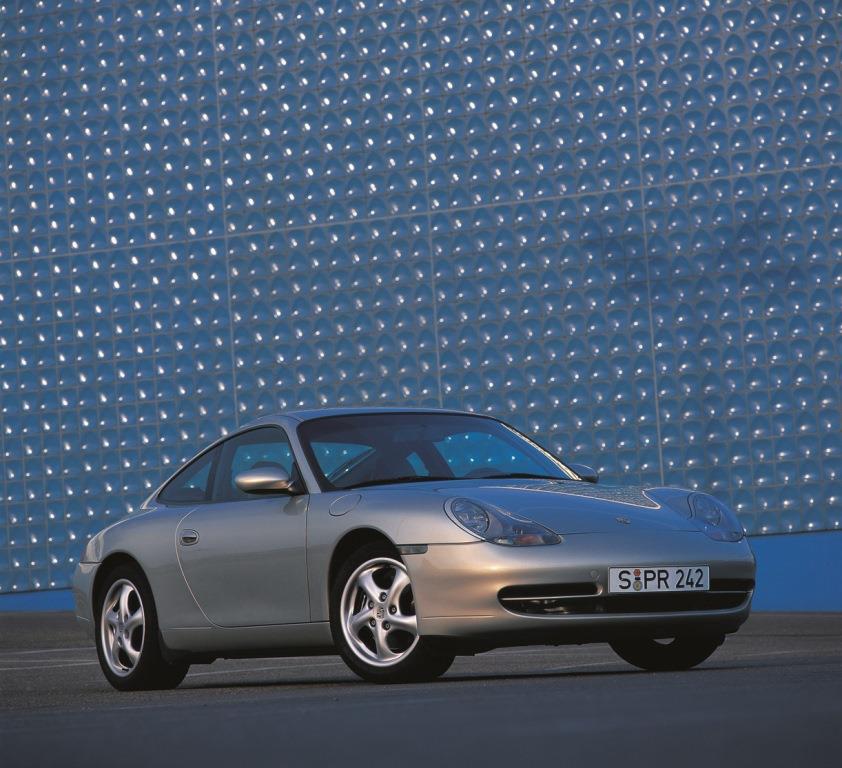
Perhaps the most striking feature of the 1999 model year Porsche 911 is the different light units, the direction indicators in the headlights and the side direction indicators now coming in white, the direction indicators in the rear lights in whitish-grey instead of orange
Porsche’s trendsetting Side Impact Protection System (POSIP) consists of two side airbags housed in the doors and additional door linings taking up impact energy in the event of a collision. Offering extra-large volume of no less than 30 litres, the two side airbags ensure optimum efficiency throughout the entire seat adjustment range, POSIP thus protecting the driver and his front passenger in all areas around their head, chest, arms and hips.
Starting immediately, the 911 coupé is available as an option with Litronic headlights, special gas-discharge units illuminating the road ahead far more brightly and thoroughly and thus significantly improving safety at night. A further contribution to your extra driving safety is the dynamic headlight range control considering not only the load the vehicle is carrying, but also any change in body angle (sway) due to dynamic driving conditions.
The halogen bulbs (H7) for the high-beam headlights are surrounded by a particularly efficient free-space reflector. Whenever the driver activates the high beams, the Litronic low-beam headlights remain switched on and also move their own beam up by way of headlight range control in order to improve illumination of the road ahead. A further feature of the Litronic headlights, finally, is the headlight cleaning system.
The features formerly combined in the sports package may now be ordered individually. Accordingly, the driver can choose from sports seats with enhanced side support, a sports suspension with even firmer and shorter springs, harder dampers and reinforced anti-roll bars as well as 18-inch turbo-look wheels measuring 225/40 ZR 18 and 265/35 ZR 18.
The Porsche 911 Carrera carries on that typical Porsche design so characteristic of the brand for the last 50 years, introducing a modern style that retains all the classic, emotional features of the car.
The good cylinder charge guaranteed by four-valve technology and stable thermal conditions ensured by water cooling make the boxer engine highly efficient. Displacing 3.4 litres, the engine develops maximum output of 300 bhp or 221 kW. Through its concept alone, the boxer is simply ideal for a sports car, combining perfect compensation of mass forces, compact dimensions, and a short, stiff crankshaft for high engine speeds.
With a drag coefficient Cd of 0.30, the new 911 offers far better streamlining than the former model with its drag coefficient of 0.34. And at 0.58 m2, the product of drag coefficient and frontal area (the latter being somewhat larger than in the past) is more favourable than on the former model. In particular, however, the new 911 excels through its lift forces reduced to a minimum, the Cfa lift factor on the front axle being only 0.08 as compared with an even lower 0.05 on the rear axle, thanks to the spoiler coming out at speed.
The 911 Carrera is a lot more spacious than its predecessor, offering both the driver and front passenger extra legroom and elbow space. And the storage area behind the rear seats provides up to 200 litres or 7.0 cu ft capacity in the Coupé.
Both the special design of the body and the use of high-quality body panels serve to enhance the proverbial stability of the Porsche bodyshell to an even higher standard than before. Torsional stiffness of the body is far better than the average figure for comparable sports cars, this extra stiffness not only offering an even greater feeling of quality, but also improving driving behaviour to a level never seen before. And it almost goes without saying that this more stable structure pays off in the event of a collision, the 911 featuring an extremely strong and resistant passenger cell able to set new standards.
Carefully calculated and defined deformation of the steel plate bodyshell keeps the loads acting on the car’s occupants in a collision to an absolute minimum. Full-size frontal airbags for the driver and front passenger naturally come as standard, as do the extra-large and efficient side airbags. A consistent quest for passive safety throughout the entire process of developing the 911 Carrera as well as the results of numerous crash tests give Porsche’s engineers the conviction that they have probably created the safest high-performance sports car in the world.
All major suspension components as well as the two axle subframes integrated in the body are made of light alloy.
Following positive experience in motor racing, Porsche has opted for four-piston light-alloy monobloc brake callipers also on the 911. The particular advantage in this case is the reduction of fading to a minimum even under extreme laods.
Benefitting from improved axle geometry, the new 911 offers even better elastokinematic correction of wheel toe position both front and rear. This keeps the car’s behaviour largely neutral all the way to extreme limits and offers extra stability and safety in bends.
Five-speed automatic transmission with small, sporting increments between gears allows perfect use of engine power. This means extra advantages both in the automatic mode and in the manual gearshift function using buttons on the steering wheel in the 911.
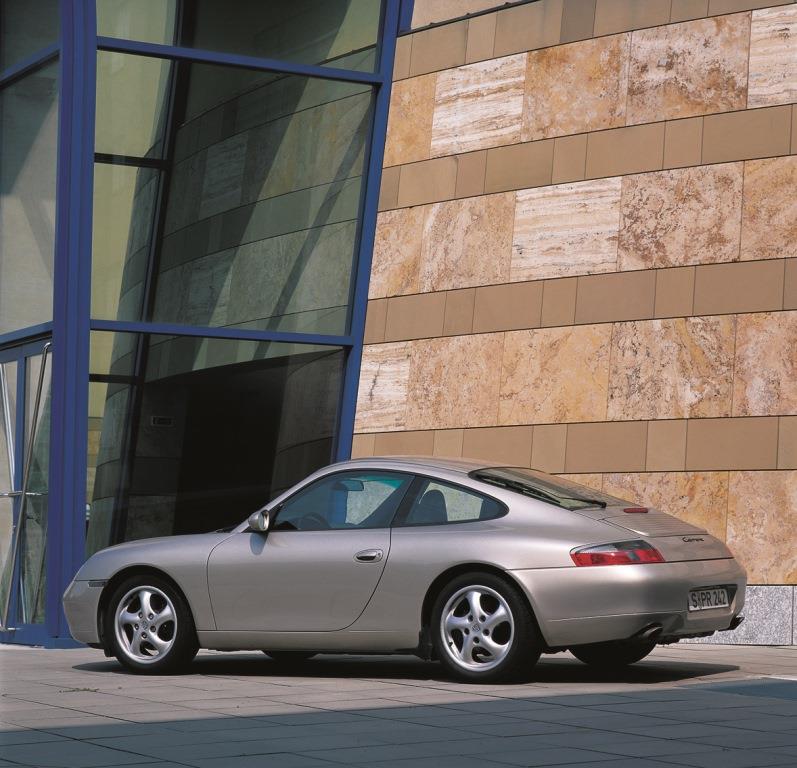
Creating the Porsche 911 for the 21st century, the engineers and designers at Porsche’s Research and Development Centre in Weissach followed their own conviction and philosophy in continuing the classic line of this unique sports car. And customers the world over have been equally consistent in supporting this philosophy, demand for the new model exceeding all expectations. Now the cabriolet, extending the model range, boosts this popularity to an even higher level.
In its design, the new 911 Coupé takes up all the main characteristics and features of the car’s classic shape. And the styling elements it uses to achieve this goal are discreet and elegant. The wings are no longer as „muscular“ as on the former model, since the entire body as such is wide enough to accommodate the suspension and tyres of a modern high-performance sports car. And in revising the classic silhouette of the 911, Porsche’s designers also found an angle for further improvement, the transition from the windscreen to the roof now flowing even more smoothly and elegantly than before. So although the 911 in principle retains the traditional line of Porsche’s most successful model, it clearly stands out as a distinctive model in its own right and is acknowledged as such in the motoring world, as is shown convincingly by the response of the market.
Streamlined and smoothened throughout, the 911 offers far better aerodynamics than its predecessor. Drag coefficient, for example, is down from 0.34 to 0.30. Although the body itself is wider and the frontal area larger than before, air resistance as a whole has been reduced to a level even lower than with other sports cars. Lift forces on both the front and rear axle, in turn, have also been minimised to an extremely low figure in the interest of enhanced safety at high speeds on the road.
Through its design, the body offers extra space wherever it really counts. Passengers enjoy more elbow room and, quite generally, a more generous feeling of ample interior dimensions. The front luggage compartment offers increased capacity of 130 litres or 4.6 cu ft, storage space behind the rear seats has also been enlarged by an additional 65 litres or 2.3 cu ft. And with the rear seats tilted down, storage space at the back is approximately 200 litres or 7.0 cu ft.
Through the new design of load-bearing structures and by using special, high-strength body panels, Porsche’s engineers have succeeded in once again significantly increasing the proverbial solidity of the 911’s bodyshell: Both torsional and flexural stability are up by approximately 50 per cent and the body itself ensures improved crumple behaviour in an accident. Crash tests by Porsche have shown that even in a severe collision the loads and forces acting on the car’s occupants are kept to a minimum.
Introducing the water-cooled six-cylinder boxer engines, Porsche has opened up a new era in engine construction. Maximum output of the 3.4-litre power units is 300 bhp (221 kW) at 6800 rpm, maximum torque 350 Newton metres (258 lb-ft) at 4600 rpm. Both fuel consumption and harmful emissions have been reduced to an exemplary level, measurements showing figures far better than even the strictest European standards. And the noise level is also far better – which means lower – than the strict limits to be introduced in future, although it almost goes without saying that the car still comes with that unmistakable Porsche sound. Particularly good news for the customer, of course, is that the time required for service and maintenance is down by 60 per cent, costs decreasing accordingly.
Both the six-speed manual gearbox and five-speed automatic transmission have been geared directly to the performance characteristics and superior torque of the water-cooled flat-six engine. The six-speed unit is compact and light, and Tiptronic S now comes with five gears for even more superior motoring.
Tiptronic S in the Porsche 911 excels in particular through its simple use. In the automatic mode the only positions for the selector lever are P, R, N and D. And once you move the lever from the right-hand automatic gate to the left-hand position for a manual gearshift, you choose the best gear simply by pressing buttons on the steering wheel.
In its gearshift characteristics, the automatic transmission follows the driver’s power and performance commands by choosing the most suitable out of five programs in the control unit, depending on the respective situation. When the driver suddenly takes his foot off the accelerator and applies the brakes, for example, the automatic transmission recognises his wish to slow down and, accordingly, shifts down and not up. The converter clutch is thus locked in a fully controlled mode as of second gear, following a program based on the driver’s typical style of motoring.
The chassis and suspension ensure effortless handling of the car in all situations. The rack-and-pinion steering, for example, comes in a position even more beneficial to the car’s steering geometry. Front wheel suspension based on the McPherson principle, in turn, features elastically connected transverse arms and longitudinal links for even better elastokinematic toe-in control to stabilise the steering effect in extremely fast bends. The rear wheels running on no less than five track control arms also change their toe-in position in bends, guaranteeing slight understeer when the car is driven to the limit. And last but not least, all wheel guidance components and their subframes are made of light alloy.
Another objective in refining the suspension was to improve both spring and roll comfort – and you certainly feel the success of the measures taken for this purpose with the standard tuning of the suspension: More than ever before, the 911 is a genuine Gran Turismo sports car ideally suited also for long distances. As an alternative, Porsche also offers a special sports suspension specifically for the really ambitious, dedicated driver.
To ensure even better performance without the slightest fading, the brake system comes with light-alloy four-piston monobloc brake callipers adequately proven in the 24 Hours of Le Mans. The benefits, of course, are maximum stopping power and minimum fading.
Aluminium wheels with 17-inch rims now come as standard, and 18-inch rims are available either as an option or as part of the sports package.
Digital Motor Electronics (DME) performs all management and control functions on the water-cooled six-cylinder. Ignition voltage goes straight from six individual coils to the spark plugs. And the fuel/air mixture is maintained by an electronically controlled injection system working individually in sequence for each cylinder on the intake stroke.
The anti-lock brake system (ABS) is naturally also supported by the most advanced computer technology. The same information provided by sensors and processed by the computer goes to the optional Automatic Brake Differential (ABD) applying the brakes individually on the drive wheels when spinning and thus ensuring a smooth and safe start-off process even on the most slippery roads. As a further feature, ABD is combined with TC Traction Control reducing engine power whenever necessary.
Increasing integration of electronic components comes to a new, logical climax with Porsche Communication Management (PCM). Fully equipped with a screen terminal and fitted right in the middle of the instrument panel, this trendsetting unit combines a whole range of functions at one and the same point:
Satellite navigation complete with road maps on a CD-ROM
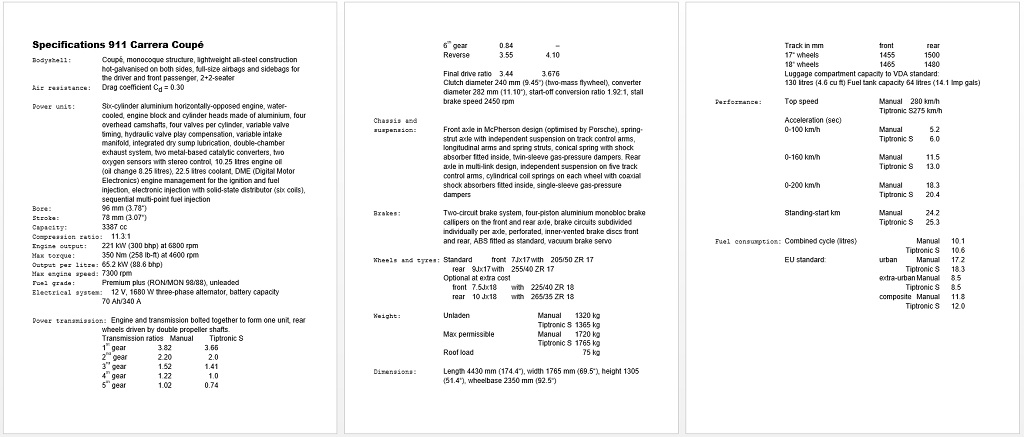
.jpg)
1998 - Porsche 911 (996) Carrera Coupé
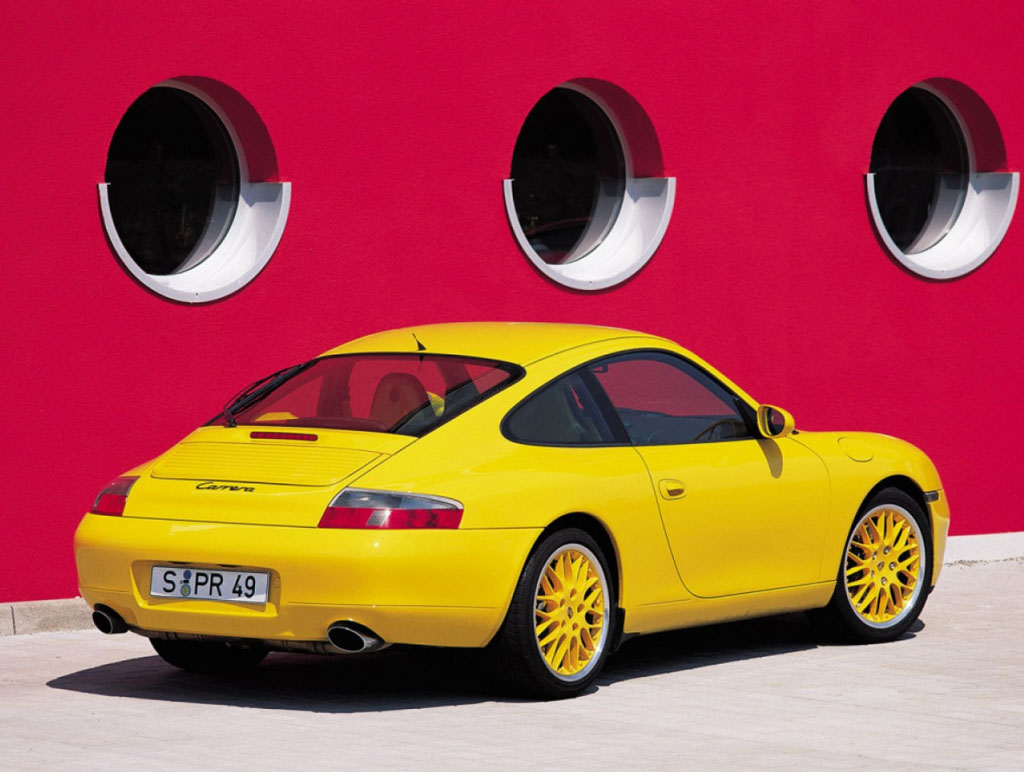
2000 - Porsche 911 (996) Carrera Coupé
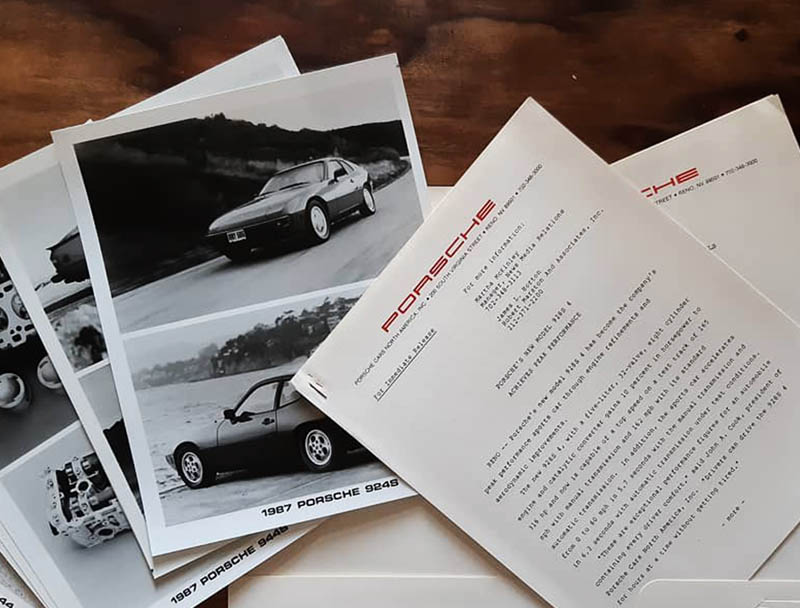
Porsche Press kit
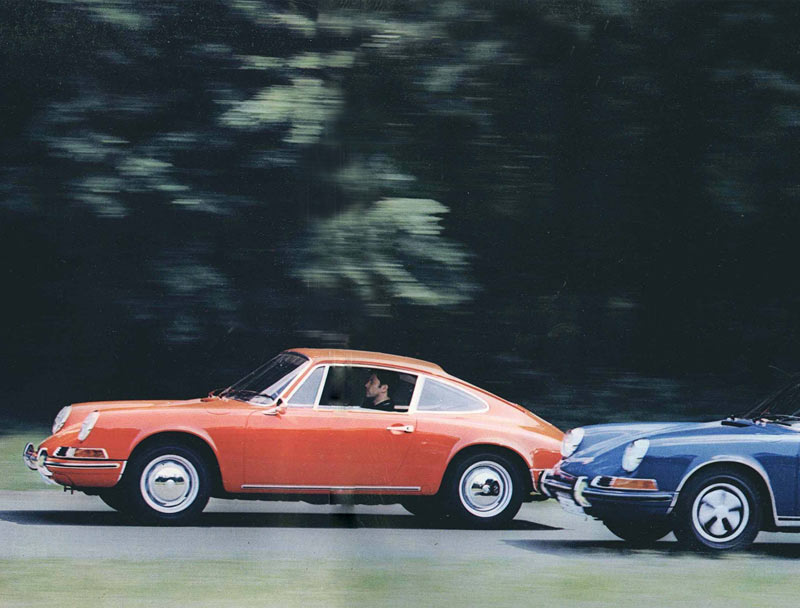
Porsche Literature
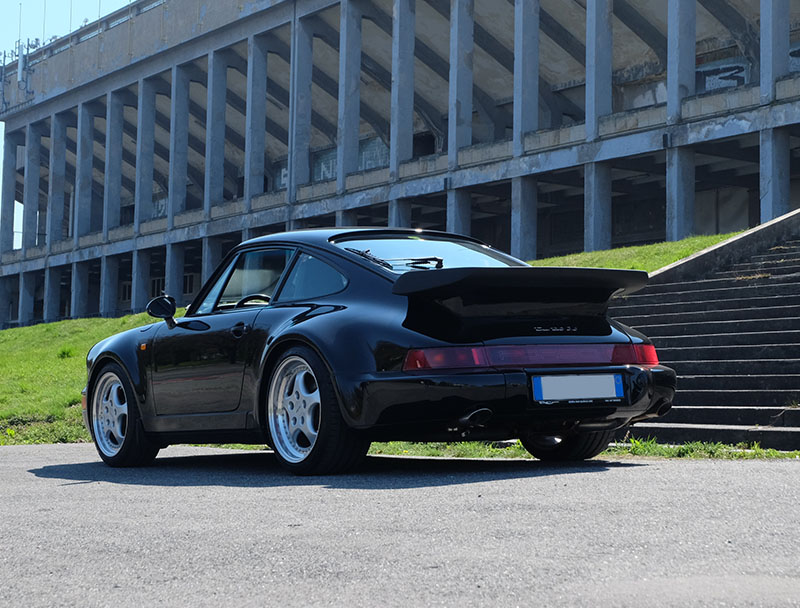
Our Porsche Cars